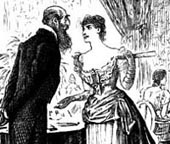The author has graciously shared with readers of the Victorian Web this passage from the second edition of her Fashion in Costume, 1200-2000 (2000), published by A & C Black (Publishers) Ltd., which retains copyright. Readers wishing to obtain of the complete book can e-mail the following address: sales@acblack.com .
 rom 1850 to 1866 the dress bodice remained very close fitting, the shoulder a little less sloping, the waist pointed, although some early-1850 bodices had a basque giving a jacket effect, and might even be in jacket form, opening over a chemisette (a white muslin or cambric fill-in often trimmed with broderie anglaise). During the late 1850s the 'princess' dress, cut without a waist seam, appeared, and in the 1860s the round waist was slightly raised. Any seaming and decoration still emphasized the small waist.
rom 1850 to 1866 the dress bodice remained very close fitting, the shoulder a little less sloping, the waist pointed, although some early-1850 bodices had a basque giving a jacket effect, and might even be in jacket form, opening over a chemisette (a white muslin or cambric fill-in often trimmed with broderie anglaise). During the late 1850s the 'princess' dress, cut without a waist seam, appeared, and in the 1860s the round waist was slightly raised. Any seaming and decoration still emphasized the small waist.
The neckline was high except for evenings: as C. W. Cunnington remarks, 'The high water mark of modesty would ebb after sunset some six inches!' (A Handbook of English Costume in the 19th Century).


Garibaldi's visit to England in 1863 gave enormous appeal to anything named after him. The Garibaldi blouse or shirt, worn for day during the 1860s in place of a bodice, was of scarlet merino trimmed with black braid; it had epaulettes, full or plain sleeves, and usually overhung the skirt, confined by a belt; so began the fashion of blouse and skirt, which has lasted with varying popularity for over a hundred years. The Garibaldi jacket for outer wear was short and made of scarlet cashmere with military braiding; a Garibaldi sleeve of thin material was full and gathered into a band at the wrist, worn for morning or afternoon occasions.

Blouses were often worn under a zouave jacket, based on the costume of the Algerian zouave troops in the Italian wars of 1859. Made of silk, velvet or cloth, it reachedjust to or slightly above the waist, the fronts rounded off and fastened at the neck only; it was one of many bolero-type jackets worn between 1860 and the 1900s. The tendency for the sleeve to widen below the elbow in the 1850s led to the pagoda sleeve, seamed on the inner side and cut to expand widely at the elbow, caught up at the bend of the arm and falling almost to the wrist at the outer edge. During the late 1850s it was slit open almost the whole length in front, hanging away at the back like an oversleeve and worn with detachable white undersleeves edged with lace or embroidery, sometimes with a matching chemisette. For evening dress, sleeves were short, puffed, ruffled or looped up, or the bodice could be sleeveless with a deep bertha collar covering the upper arm. [147-48]
Related Material
References
Nunn, Joan. Fashion in Costume, 1200-2000. 2nd edition. A & C Black (Publishers) Ltd; Chicago: New Amsterdam Books, 2000.
Last modified 13 March 2011